 | | | Switch to: Europe, USA, New Zealand, Antarctica Credit: NOAA/Ovation  Planetary K-index Planetary K-index
Now: Kp= 2 quiet
24-hr max: Kp= 3 quiet
explanation | more data
Interplanetary Mag. Field
Btotal: 3.8 nT
Bz: -1.3 nT south
more data: ACE, DSCOVR
Updated: Today at 2347 UT  Coronal Holes: 12 Apr 18 Coronal Holes: 12 Apr 18 
Earth is inside a stream of solar wind flowing from the indicated coronal hole. Credit: SDO/AIA  Noctilucent Clouds Our connection with NASA's AIM spacecraft has been restored! New images from AIM show that the southern season for noctilucent clouds (NLCs) is underway. Come back to this spot every day to see AIM's "daily daisy," which reveals the dance of electric-blue NLCs around the Antarctic Circle.. Switch view: Ross Ice Shelf, Antarctic Peninsula, East Antarctica, Polar Updated at: 02-07-2018 17:55:05 Noctilucent Clouds Our connection with NASA's AIM spacecraft has been restored! New images from AIM show that the southern season for noctilucent clouds (NLCs) is underway. Come back to this spot every day to see AIM's "daily daisy," which reveals the dance of electric-blue NLCs around the Antarctic Circle.. Switch view: Ross Ice Shelf, Antarctic Peninsula, East Antarctica, Polar Updated at: 02-07-2018 17:55:05  SPACE WEATHER
NOAA Forecasts | | Updated at: 2018 Apr 12 2200 UTC FLARE | 0-24 hr | 24-48 hr | CLASS M | 01 % | 01 % | CLASS X | 01 % | 01 % |  Geomagnetic Storms: Geomagnetic Storms:
Probabilities for significant disturbances in Earth's magnetic field are given for three activity levels: active, minor storm, severe storm Updated at: 2018 Apr 12 2200 UTC Mid-latitudes | 0-24 hr | 24-48 hr | ACTIVE | 40 % | 30 % | MINOR | 20 % | 10 % | SEVERE | 05 % | 01 % | High latitudes | 0-24 hr | 24-48 hr | ACTIVE | 10 % | 15 % | MINOR | 30 % | 25 % | SEVERE | 50 % | 35 % | | | |  | | | | | | | | | | | Lights Over Lapland is excited to announce that our aurora webcam will be up and running 365 days per year! You can now enjoy watching the Midnight Sun and all of the other drama in the sky above Abisko National Park, Sweden here. | | | CHANCE OF MAGNETIC STORMS TODAY: NOAA forecasters say there is a 50% chance of minor G1-class geomagnetic storms on April 12th as a fast-moving stream of solar wind blows around Earth. High-latitude sky watchers should be alert for auroras--and STEVE. Free: Aurora Alerts RARE VIDEOS OF STEVE: On April 10th, a G1-class geomagnetic storm was brewing over Canada as a stream of solar wind buffeted Earth's magnetic field. Matthew Wheeler of Robson Valley, British Columbia, stepped outside to see what was up--and STEVE appeared. "My dog barked at it for the entire hour it was visible," says Wheeler. "It was flowing like a river at astonishing speed." Click to play his must-see video: 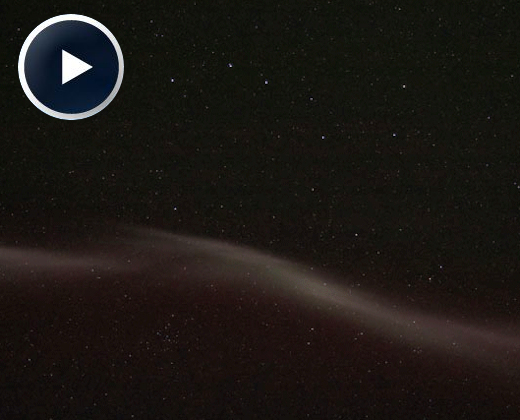
STEVE may look like an aurora, but it is not. For one thing, it is soft purple, not green like typical auroras. And it has its own special form--tightly collimated into a narrow ribbon that can bisect the entire sky. Researchers are only beginning to understand the phenomenon--aided by a chance encounter between STEVE and a European satellite a few years ago. In situ measurements revealed that STEVE is a hot (3000 degrees C) ribbon of ionized gas slicing through Earth's upper atmosphere some 300 km above the ground. It appears unpredictably during some, but not all, geomagnetic storms. Another video--"my best yet," says Wheeler--shows the beautiful interaction between the soft-purple ribbon and nearby green "picket fence" auroras: 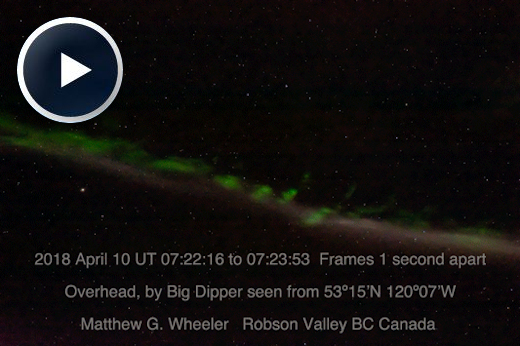
"The purple ribbon was moving much faster than the green pickets," says Wheeler. "And while their forms varied from smooth to ragged and back again, their path across the sky was almost constant for the whole hour--as it has since I first noticed STEVE over this valley in the 1980s." Does STEVE really make dogs bark? "Mine does," says Wheeler. "In addition to barking at STEVE, my giant Akbash astronomy dog, Patch, has barked at the space station since he was a pup, and proudly seen it off the farm every time. He is also a valuable spotter of meteor showers. When I hear him barking upwards, it is time to go outside." Realtime Aurora Photo Gallery MOTHER'S DAY IS ONLY 4 WEEKS AWAY: Nothing says "I Love You" like a heart-shaped pendant from the edge of space. On Dec. 31, 2017, the students of Earth to Sky Calculus flew an array of cosmic ray sensors to the stratosphere onboard a giant helium balloon. This pendant went along for the ride: 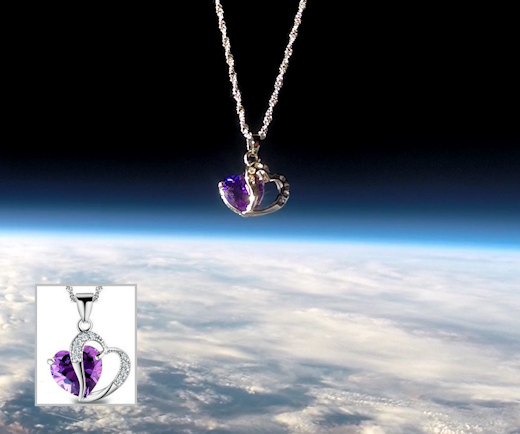
You can have it for $119.95. The students are selling these pendants as a fund-raiser for their cosmic ray monitoring program--and they make great Mother's Day gifts. All proceeds support atmospheric radiation measurements and hands-on STEM education. Each pendant comes with a greeting card showing the jewelry in flight and telling the story of its journey to the stratosphere and back again. Mom-satisfaction guaranteed. Far Out Gifts: Earth to Sky Store
All proceeds support hands-on STEM education
Realtime Space Weather Photo Gallery
Every night, a network of NASA all-sky cameras scans the skies above the United States for meteoritic fireballs. Automated software maintained by NASA's Meteoroid Environment Office calculates their orbits, velocity, penetration depth in Earth's atmosphere and many other characteristics. Daily results are presented here on Spaceweather.com. On Apr. 12, 2018, the network reported 13 fireballs.
(13 sporadics)  In this diagram of the inner solar system, all of the fireball orbits intersect at a single point--Earth. The orbits are color-coded by velocity, from slow (red) to fast (blue). [Larger image] [movies] Potentially Hazardous Asteroids ( PHAs) are space rocks larger than approximately 100m that can come closer to Earth than 0.05 AU. None of the known PHAs is on a collision course with our planet, although astronomers are finding new ones all the time. On April 12, 2018 there were 1882 potentially hazardous asteroids.
 | Recent & Upcoming Earth-asteroid encounters: | Asteroid | Date(UT) | Miss Distance | Velocity (km/s) | Diameter (m) | | 2018 GU1 | 2018-Apr-08 | 1.7 LD | 15.3 | 48 | | 2018 GN | 2018-Apr-09 | 1.1 LD | 21.1 | 20 | | 2018 GW1 | 2018-Apr-09 | 3.8 LD | 13.6 | 18 | | 2018 GN1 | 2018-Apr-09 | 2 LD | 8.8 | 11 | | 2018 GG | 2018-Apr-11 | 4.7 LD | 13.9 | 43 | | 363599 | 2018-Apr-12 | 19.3 LD | 24.5 | 224 | | 2018 GD2 | 2018-Apr-12 | 0.8 LD | 7.8 | 5 | | 2018 GP | 2018-Apr-13 | 4.4 LD | 8.8 | 14 | | 2018 GV1 | 2018-Apr-13 | 4.8 LD | 8.9 | 12 | | 2014 UR | 2018-Apr-14 | 9.3 LD | 4.4 | 17 | | 2018 GC2 | 2018-Apr-17 | 9 LD | 4.9 | 16 | | 2016 JP | 2018-Apr-20 | 12 LD | 12.7 | 214 | | 2018 GR1 | 2018-Apr-21 | 18.3 LD | 16.4 | 51 | | 2012 XL16 | 2018-Apr-23 | 15.8 LD | 6.1 | 28 | | 2018 GH | 2018-Apr-25 | 14.6 LD | 10.7 | 89 | | 2018 GB2 | 2018-Apr-27 | 17 LD | 14.5 | 95 | | 2013 US3 | 2018-Apr-29 | 10.1 LD | 7.7 | 214 | | 2018 GY1 | 2018-Apr-29 | 13.2 LD | 16.8 | 141 | | 2018 FV4 | 2018-Apr-29 | 17.7 LD | 6.5 | 58 | | 2002 JR100 | 2018-Apr-29 | 10.8 LD | 7.7 | 49 | | 1999 FN19 | 2018-May-07 | 9.7 LD | 5.7 | 118 | | 2016 JQ5 | 2018-May-08 | 6.3 LD | 10.4 | 9 | | 388945 | 2018-May-09 | 6.5 LD | 9 | 295 | | 1999 LK1 | 2018-May-15 | 13.3 LD | 10 | 141 | | 2018 GL1 | 2018-May-17 | 14.2 LD | 5.3 | 66 | | 68347 | 2018-May-29 | 9.5 LD | 13.3 | 389 | | 2013 LE7 | 2018-May-31 | 17.8 LD | 1.7 | 12 | | 2018 EJ4 | 2018-Jun-10 | 5.6 LD | 6.2 | 195 | Notes: LD means "Lunar Distance." 1 LD = 384,401 km, the distance between Earth and the Moon. 1 LD also equals 0.00256 AU. MAG is the visual magnitude of the asteroid on the date of closest approach. | | Cosmic Rays in the Atmosphere |
Readers, thank you for your patience while we continue to develop this new section of Spaceweather.com. We've been working to streamline our data reduction, allowing us to post results from balloon flights much more rapidly, and we have developed a new data product, shown here: 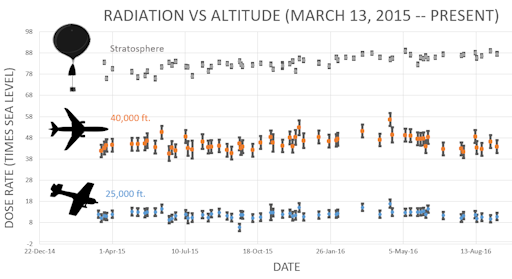
This plot displays radiation measurements not only in the stratosphere, but also at aviation altitudes. Dose rates are expessed as multiples of sea level. For instance, we see that boarding a plane that flies at 25,000 feet exposes passengers to dose rates ~10x higher than sea level. At 40,000 feet, the multiplier is closer to 50x. These measurements are made by our usual cosmic ray payload as it passes through aviation altitudes en route to the stratosphere over California. What is this all about? Approximately once a week, Spaceweather.com and the students of Earth to Sky Calculus fly space weather balloons to the stratosphere over California. These balloons are equipped with radiation sensors that detect cosmic rays, a surprisingly "down to Earth" form of space weather. Cosmic rays can seed clouds, trigger lightning, and penetrate commercial airplanes. Furthermore, there are studies ( #1, #2, #3, #4) linking cosmic rays with cardiac arrhythmias and sudden cardiac death in the general population. Our latest measurements show that cosmic rays are intensifying, with an increase of more than 13% since 2015: 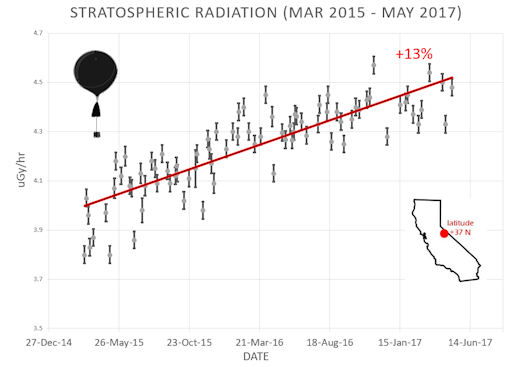
Why are cosmic rays intensifying? The main reason is the sun. Solar storm clouds such as coronal mass ejections (CMEs) sweep aside cosmic rays when they pass by Earth. During Solar Maximum, CMEs are abundant and cosmic rays are held at bay. Now, however, the solar cycle is swinging toward Solar Minimum, allowing cosmic rays to return. Another reason could be the weakening of Earth's magnetic field, which helps protect us from deep-space radiation. The radiation sensors onboard our helium balloons detect X-rays and gamma-rays in the energy range 10 keV to 20 MeV. These energies span the range of medical X-ray machines and airport security scanners. The data points in the graph above correspond to the peak of the Reneger-Pfotzer maximum, which lies about 67,000 feet above central California. When cosmic rays crash into Earth's atmosphere, they produce a spray of secondary particles that is most intense at the entrance to the stratosphere. Physicists Eric Reneger and Georg Pfotzer discovered the maximum using balloons in the 1930s and it is what we are measuring today. | | The official U.S. government space weather bureau | | | The first place to look for information about sundogs, pillars, rainbows and related phenomena. | | | Researchers call it a "Hubble for the sun." SDO is the most advanced solar observatory ever. | | | 3D views of the sun from NASA's Solar and Terrestrial Relations Observatory | | | Realtime and archival images of the Sun from SOHO. | | | from the NOAA Space Environment Center | | | fun to read, but should be taken with a grain of salt! Forecasts looking ahead more than a few days are often wrong. | | | from the NOAA Space Environment Center | | | the underlying science of space weather |  | Reviews here can help you to pick up best memory foam mattresses. | | | These links help Spaceweather.com stay online. Thank you to our supporters! | | | | | | | | |  | |  |   | ©2017 Spaceweather.com. All rights reserved. This site is penned daily by Dr. Tony Phillips. | |

